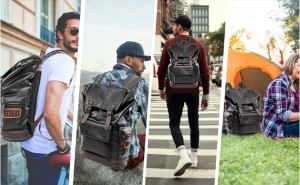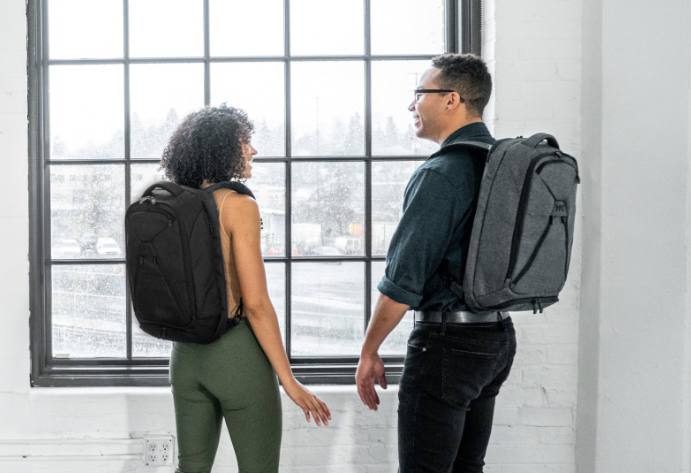Ever wondered what is the standard backpack size in inches? Backpacks have become an important everyday item for many people. It’s a safe haven for multitaskers. Just sling the bag over your shoulders, and boom, your hands are free for other chores. Similarly, for travelers, a travel backpack is the choice as it can carry all your essential items close to your back.
Besides all these benefits, if you end up buying a backpack that is the wrong size, you might end up straining your body. So, selecting the backpack of the right size can be challenging when you have thousands of options in terms of types, sizes, and designs. That’s why in today’s article, I’ve described all the details about the backpack, its types, and standard backpack size in inches that are available in the market so that you can choose the best backpack for you.
Why is a Backpack so Special?
A backpack is special because it’s not your traditional bag. It’s a bag you put on your back with fashion and style. It’s easy to carry, and the sky’s the limit for its usage. From your daily use items to your house essentials, you can add any important thing to your backpack. But, yeah, the size and type of backpack matter.
Backpack Types:

Backpack Types
Many different types of backpacks are available on the market. If you want to buy a perfect backpack, it’s important for you to learn about all the types. Here are a few backpack types:
- Daypack
- Weekend Backpack
- Overnight Backpack
- Hiking Backpack
- Travel Backpack
- Hydration Backpack
- Laptop Backpack
- Tactical Backpack
- Rolling Backpack
- Camera Backpack
- Climbing Backpack
- Ultralight Backpack
- Duffel Backpack
- School Backpack
- Ski Backpack
- Rucksacks
- Skate Backpacks
- Running Backpack
- Military Backpack
- Drawstring Backpack
- Tote Backpacks
- Hunting Backpack
- Crossbody Sling Backpack
- Cycling Backpack
- Biking Gear Backpacks
- Carry-on Backpacks
- Wheeled Backpacks
Backpack Sizes:
As I’ve already explained, there are different backpack sizes. There’s no one size that fits all. You need a backpack that fits your requirements to use it to the fullest. Here are a few backpack sizes to help you understand standard backpack dimensions:
- 10-20 liters (Small)
- 20-30 liters (Medium)
- 30-40 liters (Large)
- 40-50 liters (Extended)
- 50-65 liters (Multi-day)
- 65-80 liters (Expedition)
- 80+ liters (Extra Large)
Standard Backpack Size in Inches:
Well, many people understand backpack dimensions in liters. Some people like to understand standard backpack size in inches, so here are the dimensions in inches for you to get the best backpack:
- Small Backpack: 17 x 10 x 6 inches
- Medium Backpack: 18 x 12 x 8 inches
- Large Backpack: 20 x 14 x 10 inches
- Extra Large Backpack: 22 x 16 x 12 inches
That’s it. With this knowledge in your hand, go to Market and buy the premium backpack that meets your requirements.
Normal Backpack Size:
An everyday backpack size typically ranges between 20 to 24 liters in capacity, with standard backpack dimensions around 18 x 12 x 8 inches. This size is commonly used for school, work, or daily activities.
Standard Backpack Size in Inches For Adults
Standard Backpack Size For Men:

Standard Backpack Size For Men
The man has a larger backpack than the females because their torsos are generally larger. It’s because usually, men need to carry more weight or luggage, so bigger bags, bigger torsos.
The standard backpack size in inches for men is as follows:
Small (S) Size Backpack for Men: 16-18 inches
Medium (M) size Backpack for Men: 18-20 inches
Large (L) size Backpack for Men: 20 to 22 inches
Standard Backpack Size For Women:

Standard Backpack Size For Women:
The backpack size of women is smaller than males. They have shorter torsos compared to men. The straps of the female backpacks are both slimmer and shorter.
The standard backpack size in inches for females is as follows:
Extra Small (XS) Size Backpack for Females: 13 to 14 inches.
Small (S) size Backpack for Females: 14 to 16 inches.
Small Medium (SM) size Backpack for Females: 16 to 18 inches.
Medium (M) size Backpack for Females: 18 to 19 inches.
Dimensions, sizes, lengths, and widths come second; preferences come first. All the backpacks are excellent carriers; all you need to do is buy a backpack that suits your expectations.
Backpack Size Chart For Kids:

Backpack Size Chart For Kids
Today’s kids are the elite, and they need updated and modern gadgets for schooling. Traditional school bags don’t please them anymore; they need modern backpacks. Isn’t it?
The standard backpack size in inches for kids is as follows:
Age of kid (in years) 4: 11 inches
Age of kid (in years) 5: 12 inches
Age of kid (in years) 6: 12.5 inches
Age of kid (in years) 7: 13 inches
Age of kid (in years) 8: 14 inches
Age of kid (in years) 9: 14.5 inches
Age of kid (in years) 10: 15 inches
Age of kid (in years) 11: 15.5 inches
Age of kid (in years) 12: 15.5 inches
Age of kid (in years) 13: 16 inches
Age of kid (in years) 14: 17 inches
Age of kid (in years) 15: 17.5 inches
Age of kid (in years) 16: 18 inches
How To Understand Backpack Capacity?
All these dimensions, sizes, and types might have confused you and left you scratching your head and wondering what the right backpack size is for you and how you can measure the backpack’s capacity.
It’s easy. The capacity of a backpack is mentioned on the volume tag, usually in liters. In this case, keep two points in mind:
- Backpacks under 20-liter are relatively small.
- 20-25 liter backpacks are best for schools and offices.
And definitely, the size of the backpack increases as the liter count increases.
In some backpacks, you might see other types of measurements, such as kilograms and inches, which indicate how much weight they can hold, their length, etc.
Which Backpack Size is Best For You?

Which Backpack Size is Best For You
It actually depends on you because backpack dimensions vary. There is no perfect size that fits all. To choose the ideal backpack, you should analyze the following situations:
- Your need.
- Your budget.
- The backpack’s capacity.
- The torso range.
- The backpack’s size.
- The type of backpack.
Note that it’s important that you buy the right size and type of backpack to facilitate you fully otherwise, imagine going hiking with a biking backpack. Ugh!
On a lighter note, it was just to help you realize the importance of a standard backpack.
How to Measure Your Torso for the Perfect Fit?
When selecting a backpack, one of the most crucial factors is ensuring that it fits your torso length correctly. A poorly fitting backpack can cause discomfort, back pain, or even injury if you’re carrying heavy loads. Here’s a simple method to measure your torso:
- Find your C7 vertebra – This is the prominent bone at the base of your neck when you tilt your head forward.
- Locate your iliac crest – This is the top of your hip bones on either side of your waist.
- Measure the distance – Use a measuring tape to measure the length between your C7 vertebra and the iliac crest. This is your torso length, and it will help determine which backpack size is best suited for you.
By knowing your torso length, you can choose a backpack that aligns with your body’s frame, ensuring optimal comfort and support.
More info: Common Item That What Weighs 10 Pounds 2024
Conclusion:
Choosing an ideal backpack is important if you don’t want to experience discomfort when using it. Similarly, it’s crucial that you consider different types and standard backpack sizes in inches to get the best Standard Backpack Size in Inches. Happy Shopping!



